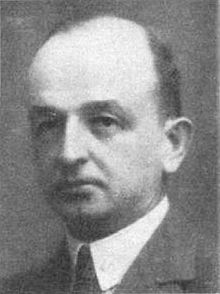|
Karl-Siegmund Litzmann
Karl-Siegmund Hermann-Julius Litzmann (1 August 1893 – ? August 1945) was a Nazi German politician and SA-Obergruppenführer who commanded SA Equestrian troops and training. He also served as the Generalkommissar during the German occupation of Estonia in the Reichskommissariat Ostland from December 1941 to September 1944, and died under unexplained circumstances after the close of the Second World War in Europe. Early yearsLitzmann was born in Minden, the son of Imperial German Army General Karl Litzmann, and was the uncle of Walter Lehweß-Litzmann. In 1905, Litzmann enrolled in cadet school and was appointed a Fahnenjunker in 1911. In November 1913, after completing the officer course in Paderborn, he received his commission as a Leutnant. He was assigned to Reserve Infantry Regiment 261, served throughout the First World War and was wounded three times. He earned both classes of the Iron Cross as well as the Knight's Cross of the House Order of Hohenzollern with swords. In 1919 Litzmann received training in agricultural management from the large landowner Carl Wentzel in Teutschenthal and in 1921 he took over the administration of the Wentzel estate near Insterburg in East Prussia (today, Chernyakhovsk, Kaliningrad Oblast). Political careerIn 1929 Litzmann joined the Nazi Party and the Sturmabteilung (SA), the Nazi paramilitary organization. As an early Party member, he would later be awarded the Golden Party Badge. In 1930 as an SA-Standartenführer, he was commissioned with the development of what would become the Reiter-SA (Equestrian SA). This involved the incorporation of horse breeding and riding clubs into the SA and their merger with mounted SA units, the SA cavalry.[1] In 1931, Litzmann was promoted to SA-Gruppenführer and named the commander of SA-Gruppe Ostland. In July 1932, Litzmann was elected to the Landtag of Prussia as a Nazi deputy, and served until its dissolution in October 1933. On 12 November 1933, he was elected to the Reichstag from electoral constituency 1 (East Prussia). He waa reelected in 1936 and 1938, and retained his seat until the fall of the Nazi regime.[2] Litzmann was promoted to SA-Obergruppenführer on 27 June 1933, and in July he took command of the newly formed SA-Obergruppe I comprising East Prussia. Also on 11 July 1933, he was named to the Prussian State Council by Prussian Minister President Hermann Göring.[3] In the summer of 1934, Litzmann escaped the liquidation of the SA leadership by the SS in the Night of the Long Knives. He was ordered by Adolf Hitler to stay away from the SA leadership meeting held at Bad Wiessee on 30 June 1934. Hitler probably wanted to spare General Karl Litzmann, whom he greatly admired, from the pain of having his son murdered. In 1935, Litzmann was made a member of the People's Court.[4] He also was appointed Reichsreiterführer (Reich Equestrian Leader), the highest authority for horse breeding and racing. He was charged with establishing the Reichsreiterführerschul (Reich Equestrian Leadership School) in Berlin-Zehlendorf which he led as Reich Inspector of SA Equestrian Schools. He also was placed in charge of preparing the German riding team for the 1936 Summer Olympics. In order to ensure a uniform training standard for all mounted units of the SA, SS and Hitler Youth, the Nationalsozialistisches Reiterkorps (National Socialist Equestrian Corps) was formed in March 1936. Although this organization was technically separate from the SA, Litzmann who headed it as Reich Inspector for Equestrian and Driving Training, reported directly to SA-Stabschef Viktor Lutze.[1] Generalkommissar in Estonia In 1941, equestrian training was discontinued for the SA and the Wehrmacht. Litzmann was assigned to be Generalkommissar for the Generalbezirk Estland in the Reichskommissariat Ostland with headquarters in Reval (today, Tallinn).[5] Under him, the SS murdered many thousands of Estonians, Jews and Soviet prisoners of war. On 17 September 1944, the Red Army launched the Tallinn offensive and Litzmann left for Hungary. He became an SS-Sturmbannführer in the Waffen-SS on 30 January 1945.[4] After the fighting in Hungary in the spring of 1945, he was considered missing in action. In May 1945, however, Litzmann turned up under a false name living with his sister in Kappeln, and reportedly died under unclear circumstances in August 1945. In the spring of 1946, the family estate in Neuglobsow was expropriated as part of land reform under the Soviet occupation. Litzmann was officially declared dead on 31 July 1949.[4][6] See also
References
Sources
External linksWikimedia Commons has media related to Karl-Siegmund Litzmann.
|
||||||||||||||||||||||||||||||||||||||||||||
